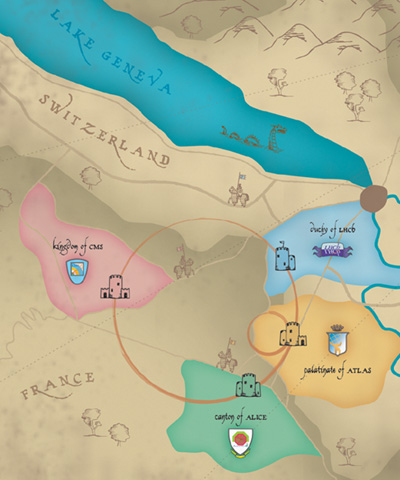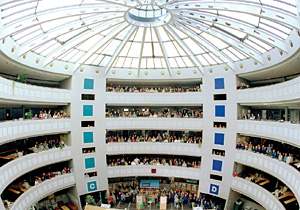City-States of Science
by Mike Perricone
Tomorrow's particle physics experiments are redrawing the map for scientific collaboration. Although the field has long been accustomed to large groups of scientists, life in the new CERN collaborations will surely be different.
 |
If the CMS collaboration ever decides to order pizza, it will take a fleet of trucks to make the delivery. They'll need to be fast, too, because they'll be delivering to at least 10 different time zones on six continents. Just who was it who ordered the anchovies?
The particle physics experiments of the future, with 2000-plus collaborators from every corner of the globe, will push the art of scientific collaboration to a whole new level -- and not just for ordering pizza. Author lists for scientific papers will be many pages long. Getting everyone together for a group photo may never happen.
Although particle physics collaborations have long numbered in the hundreds, the scale of experiments at the Large Hadron Collider, now completing construction at CERN, the European Particle Physics Laboratory, will be unprecedented; and life in the new collaborations will surely be different.
As LHC start-up approaches, thousands of the world's scientists are converging on the largest-scale particle physics experiments ever conducted. Collectively they are assembling and will operate the most complex detectors ever constructed, to advance understanding of the fundamental nature of the universe. Many of the physicists who collaborate on these experiments, however, might seldom get close enough to shake hands or share a beer at the end of a shift. Making it all work will take new ways of organizing experiments, with new policies and customs, and new ways to communicate.
When the LHC begins operations later in the decade, four major experiments will start collecting data. With 600 members, the smallest of these experiments, LHCb, is already about the size of the largest previous particle physics collaborations. Yet it will be dwarfed by the other three experiments.
The CMS experiment comprises the largest scientific collaboration ever assembled. It already has over 2000 members from 160 institutions in 36 countries; its members speak at least 50 languages. The ATLAS experiment has 1800 members from 150 institutions in 34 countries. And the ALICE experiment has 1000 members from 76 institutions in 26 countries. These collaborations will only grow as the LHC start-up time approaches.
New world order
Each of the LHC experiments is a scientific world unto itself. Members will not only come from around the globe, but the organizational structures, processes, infrastructure, and methods of communication will resemble those of small governments. The CERN laboratory, outside Geneva, Switzerland, will be the center of each experiment, but each collaboration will stretch far beyond the borders of its European home, each city-state with offshoot colonies distributed through institutions worldwide.
Managing these organizations will not be an easy task: it will require new approaches.
Take the governance of ALICE as an example of the collaborations' structure. At the top is the Collaboration Board, the policy and decision making body. At the next level, the Management and Finance Boards supervise the progress of the experiment along the lines defined by the Collaboration Board, and make recommendations to it. At the next level, the Technical Board assesses technical aspects of the detector -- design, coordination, and technical execution of the experiment -- as directed by the Collaboration Board. The Off-line Computing Board manages computing concerns such as the central coordination, maintenance, and distribution of software, and selecting simulation frameworks and code. The Physics Board coordinates and assesses activities concerning physics topics, including the simulation and optimization of the physics performance of ALICE. It coordinates conference contributions, publications, and internal ALICE notes. Below these boards are still more organizational structures dealing with safety, administrative support, and the Secretariat.
It may seem a cumbersome and complex structure for a science experiment, but it is essential to coordinate the activities of thousands of participants who are contributing to results that must represent the efforts of the experimental collaboration as a whole.
"You are trying to get everyone on the same page, and to do that you need spokesmen, representatives, boards, and committees," says Fermilab physicist Dan Green, Technical Director and Project Manager of the US CMS group.
The experiences of scientists and engineers at Fermilab, Stanford Linear Accelerator Center, Deutsches Elektronen-Synchrotron, KEK in Japan, and CERN will certainly help. Unlike the CERN collaborations, however, experiments such as CDF and DZero at Fermilab and BaBar at SLAC started small and had years to adjust as they steadily added members.
"We were allowed to learn as the experiments grew," says former CDF spokesperson Nigel Lockyer. "We weren't just handed all these people."
SLAC's David MacFarlane concurs. "The original members put their stamp on the experiment. The new people adopt the culture that the original people left there. Everything gets passed down."
 |
Globally connected
Currently operating particle physics collaborations have pioneered effective methods of operation and communication for large experiments. The World Wide Web famously evolved from its first use as a tool for remote collaboration in high-energy physics. At Fermilab's DZero collaboration, remote operations by colleagues around the world are becoming routine. Nevertheless, the vastness of the future experiments presents fresh challenges. A smaller fraction of collaboration members will be physically located at the experiment at any one time than for previous experiments. Sheer size combined with sophisticated tools for electronic access means that all of the LHC experiments expect to have what amount to remote members.
"With computing activities and offline analysis," says Jurgen Schükraft of ALICE, "it is clear that some experimenters will not set foot at CERN for their work. This does not mean that they will not come, from time to time, for collaboration meetings. However, some -- from remote corners of the world, or some who are members of ALICE for a short time only, or for a limited activity -- may actually never come here."
Technology will help keep the far-flung collaboration connected.
"The collaborations are globe-spanning," says Green, "and we need to deploy all the new tools we can find, such as video conferencing, remote operations, grid tools, e-logbooks, and the like, to tie the community together."
The standard control room, housing all the equipment, is becoming a thing of the past, according to CERN's David Barney of CMS. "Every member of the collaboration will be able to monitor the experiment from an office, or even via mobile phone. Indeed there is already connectivity between equipment control software -- for example, LabVIEW -- and mobile phones that send automatic alarms to on-call experts. Equipment debugging can take place from our homes, as broadband Internet connections become commonplace. Experts will even be able to start and stop runs and change configurations from home."
Steps toward this type of remote control are already in place. Barney points to webcams at the CERN experiments that allow remote collaborators to watch construction and help debug equipment installation. US CMS has operated remotely for test beams from Fermilab and is planning a Remote Operations Center there for data taking. The extensive use of electronic collaboration tools enables greater participation in the US CMS data-taking than would otherwise be possible.
Another challenge arising at LHC is that CMS and ATLAS will be the most data-intensive physics experiments ever. Data grids, connecting computational and data storage resources in a worldwide framework, will be critically important to provide the data to collaborators for physics analysis. The Grid is already paying off, according to Barney.
"Collaborators from Delhi University in India working on the CMS pre-shower subdetector are currently performing simulations using grid tools running on farms of PCs at Fermilab," he says.
Home away from CERN
For US members of collaborations, a home away from CERN already exists at Fermilab, in the LHC Physics Center (LPC) on Wilson Hall's 11th floor. The LPC will provide a local site where physicists can work with experimental colleagues and perform many day-to-day operations of LHC experiments and data analysis, all connected electronically to CERN -- and all within steps of a world-class espresso machine. Still under development is a Fermilab "remote control room" where physicists could monitor CERN operations in real time.
Having a central place for US members to congregate will help with communication issues. Green believes that there is no substitute for personal contact. "Physicists need to be face-to-face, and that is one reason why we initiated the LHC Physics Center," he says. "You need to listen to what people are trying to tell you, instead of only what they are actually saying."
 Members of the ATLAS collaboration gather at CERN. Photo: CERN |
People working together
Almost as much as technology, sociology counts. Many small working groups within the collaboration and around the world bring participants together. Barney grants that the sizes of the CERN experiments seem to rule out the kinds of all-inclusive social gatherings where earlier collaborations have celebrated milestones and talked things through together over food and drink.
"These kinds of events are generally organized within a subdetector group," he says. "There is a good intragroup atmosphere, but it is difficult to expand to encompass the complete collaboration."
However, the collaborations try to bring as many members as possible together face-to-face at meetings and workshops throughout the year. At ALICE, Schükraft describes an emphasis on contact through working relationships.
"Nobody works in isolation," he says. "There is always a project or working group in which everybody is embedded and has close personal contacts. I don't think everybody has to meet everybody else, physically."
Nevertheless, ALICE invests significant effort to bring together as many people as possible, as regularly as practical. Schukraft outlines a carefully-structured cycle of formal meetings and other opportunities for connection: regular five-day collaboration meetings are held at CERN three times during the year, with another held at a collaborating institution; monthly meetings of groups such as the Technical Board, the Management Board, the Physics Board, and the Off-line Computing Board; external boards or group meetings, both restricted and public; and regular seminars and open meetings for collaborators to present their work.
Besides the formal governance, ATLAS spokesperson Peter Jenni describes specific qualities the collaborations need in order to maintain cohesiveness.
"Among the key elements must be openness, clear procedures, and the knowledge that excellent work will be the most important element for recognition," he says. "I hope there will be a team spirit developing, also, for the physics analysis phase. This will be important in the future, not only now, during the construction phase."
Despite the challenges facing the LHC collaborations, and the different ways of working they will need to adopt, one thing has not changed -- the pursuit of scientific knowledge.
Jenni underscores the primacy of the science goals. "I hope the culture of ATLAS...will be one of the highest standard of scientific excellence, and the excitement of sharing the privilege to do frontier physics."
When the collaborations of the future prepare to celebrate the first scientific results from the new energy frontier, they may even discover a way to hold the world's largest physics pizza party.
Click here to download the pdf version of this article.






